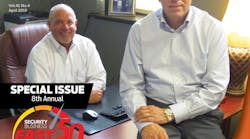This article originally appeared in the May 2020 issue of Security Business magazine. When sharing, don’t forget to mention @SecBusinessMag!
Many companies, including Select Security, have been forced to make the difficult decision to reduce hours or let go of employees as a result of the COVID-19 pandemic. As difficult as those decisions were, we also had to consider the effects on those remaining at work, keeping them safe and productive in a quickly changing environment.
In the new normal, remaining at work no longer means remaining at a desk. Like many companies, Select Security had to quickly come up with plans to adapt a traditional workforce (and many of our processes and procedure) to a new work from home environment – and it had to happen in a matter of days, sometimes hours.
To serve its customer base of nearly 80,000, Select Security has three call centers. One is the central station monitoring center, the second is a service coordination center, which handles all technical service needs, and the call center I am responsible for is the Customer Experience Center. Select Security’s adaptation plan called for me to transition all employees in this third call center into a work-from-home environment.
The Role of the Customer Experience Center
As opposed to more highly-staffed central stations, our Customer Experience Center comprises a group of about 20 people, who handle all of the typical customer care needs. It also includes an inside sales department. On average, the Customer Experience Center handles nearly 10,000 inbound calls per month, in addition to leads coming from our service department, customer emails and tickets from the central station monitoring center. This group is undoubtedly essential to the continued success of our company.
Because our processes were built around a centralized call center atmosphere, changing how that business is conducted was no small feat. Not only did we have to consider the technology impact of working offsite, but also the cybersecurity implications.
While this focuses on our Customer Experience call center, that was certainly not the only group of employees at Select Security who were forced to transition to a work-from-home environment. Every part of the organization had to go through the same thing, and in large part it went smoothly, with little pain and hiccups. Organization-wide planning played a key role in our ability to transition a large percentage of our work force out of the office, while remaining highly productive.
Beginning in late February our senior leadership team held daily COVID update meetings that included other key managers to talk about the rapidly evolving situation and our responses. That, along with regular video communications sent company-wide, helped to keep everyone updated and on the same page. As an essential business, we felt a responsibility to not only maintain service for our customers, but also to create the opportunity to keep as many people productively employed as possible.
Suddenly, the new reality was a large section of our workforce was faced with difficult decisions regarding their health and the welfare of their families, especially with the closure of schools and community resources.
Thanks in large part to our amazing IT department, and our constant planning and communication, we were able to complete the entire transition to work-from-home in just three days. As it turns out, the actual transition was the easy part.
Transition Tips
Select Security was not alone in the need to quickly create and launch work-from-home programs; however, like many integrators, we are settling into a new normal. With everyone at home, we must now focus on maintaining efficiencies and the positive work culture that our company has worked so hard to build. Here are three keys to accomplishing those goals:
1. Think about things differently.
The whole change from working in an office to working at home was easy for some, but for others, it required a fundamental shift in thinking. Despite the recent increases in businesses offering work-from-home positions, most people have been conditioned to think that work belongs at in an office – where you have file cabinets, a break room and your favorite “work wife” or “husband.”
People new to the work-from-home atmosphere – and even those who have done it for years – have encountered some new inconveniences. They range from simple things like finding a quiet space to work in, to helping bored kids find something to do, to helping school kids with distance learning. Those who are accustomed to the office are frustrated by not being able to run to the file cabinet when they need old customer paperwork, or no second computer screen to have multiple windows open. Add the sudden loss of in-person, face-to-face department meetings, and things can get stressful.
As a manager in this situation, it is vital to remain calm yourself, and to understand the often massive amount of additional stress facing your employees. Be patient and listen to their new needs. Try to be as flexible as possible with work hours and supervision. In the end, you must look at the situation differently than when you had your team safely under one roof – adjust to survive.
2. Communication is key.
No surprise, but the key to overcoming much of this transitional stress is finding good ways to communicate. The best laid plans can fall apart without properly sharing information and escalating issues and concerns. Moving away from a personal contact workplace added another wrinkle since many team members are forced to use new technology – such as video conferencing – for the first time.
Finding new ways to communicate – and getting buy-in from the entire team in using them – is an area where both I and my Customer Experience Manager Keeya Woods are continuing to focus and learn. One of Select Security’s Core Values is to be a compelling place to work, and over the years, Keeya and I have worked hard to build a positive culture in our department. Suddenly, however, we were faced with the reality that we could no longer foster those workplace relationships in the same way, and one of our biggest fears was the loss of the team-oriented culture.
Finding new ways to leverage technology down through all layers of the organization has helped us keep in contact and communication. In the Customer Experience Center, we use the internet-based chat program Slack to help replace the normal helpful chatter that happens among employees in a call center. We require all team members to always keep open and use the program, which helps the team keep track of who is on break, and also to get quick peer assistance on common questions and issues.
3. Evaluate Performance
Call centers are driven by data, and there is simply no viable way to properly manage one without being able to measure call volume and other key metrics.
The need for data becomes even greater when faced with managing a remote workforce. In the old environment, it is easy to see in person if someone has not returned from their break; in a virtual environment, it obviously becomes much harder.
To properly manage the granular aspect of job performance, we looked again at the data available to us and how it was presented. It is critical to monitor dashboards and reporting in the most detailed way possible. Pay close attention and make sure you have created the ability to measure performance against others in the same position and phone queue to get a better sense of each individual’s overall work performance. It is easy to let customer service slip in this environment; however, customer service is more critical than ever in a crisis like this.
No one knows what the future holds, but the new reality is that businesses need to be incredibly flexible to ensure continuity. Hopefully, these three tips will help fellow integrators survive and perhaps even see ongoing value in a work-from-home model.
Joseph Mitton is Director of Marketing and Customer Experience for Lancaster, Pa.-based security integrator Select Security, which was named North America’s fastest-growing security integrator as part of the 2019 Security Business Fast50 (read more at www.securityinfowatch.com/21074244).




